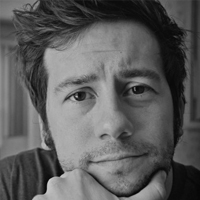 With Hope For A Cure
With Hope For A Cure
Dylan Duncan
My mom, aunt and grandmother all died of Hereditary Amyloidosis. I was about 10 years old when I was first exposed to the devastating effects of the disease and it lived with my family and I until I was 17. Time passed after my mom died and at the age of 26, I started to experience some numbing sensations in my arm and hands. I am an artist and I play guitar, so ordinarily I’d suspect these to be the cause. However, I knew that one of the symptoms of Amyloidosis was carpal tunnel syndrome and that my mom also had issues with her hands before she got sick.
In 2006, I went in for my genetic testing and six weeks later, I received the call from Dr. Skinner, the Director of the Boston Amyloid Treatment & Research Program at the time, who confirmed my suspicions that I carried the TTR gene. A year later, I went in for my fat pad biopsy and was officially diagnosed with Hereditary Amyloidosis after protein deposits were discovered in my tissue.

From there, I enrolled in the Diflunisal clinical trial lead by Dr. John Berk. For two years, I was closely monitored by the research team at Boston University School of Medicine through a series of tests given over the course of the trial. When it was over, they offered me an open label prescription of the drug and I have been on it ever since. Throughout this time, I was working with friends and family to organize community fundraising events to help raise money and awareness of the disease, becoming acquainted with Mary O’Donnell and The Amyloidosis Foundation in the process.
Every year since my diagnosis, I returned to Boston Medical for my evaluations. My results continued to be normal and it looked as if the medicine was keeping things at bay. It wasn’t until a year or so ago when I started experiencing other symptoms – sexual dysfunction, incontinence, dizziness upon standing up, fatigue and reoccurring incidents of nerve pain in my feet and legs. In September of 2014, I went in for my annual visit and my neurological testing results showed a change from the year before. My echocardiogram, too, sparked small concern and it was recommended that I go in for a cardiac MRI. Results from the screening showed possible heart wall thickening, which then lead to my having some nuclear tests done on my heart to allow for a better view of what was going on. The results suggested early signs of amyloid protein present in the heart.
With the symptoms I am experiencing in my everyday life and the results coming in from Boston Medical, I cannot help but be afraid. I know that I am in good hands, however, and Dr. Berk has assured me that I am being watched closely. There are more clinical trials going on right now and hopefully I will be able to participate in one of them sometime soon. I find comfort in knowing that I am staying proactive with my disease and doing what I can to help raise awareness.
My sister recently went in for testing as she also has the genetic mutation and is beginning to show signs of disease progression. If that wasn’t scary enough, there is a 50/50 chance that her 2-year-old daughter will also inherit the disease. With new research and drugs developing all the time, I am hopeful that there will someday be a cure. Although a cure may not benefit me, it could help save my sister, niece and others around the world.
